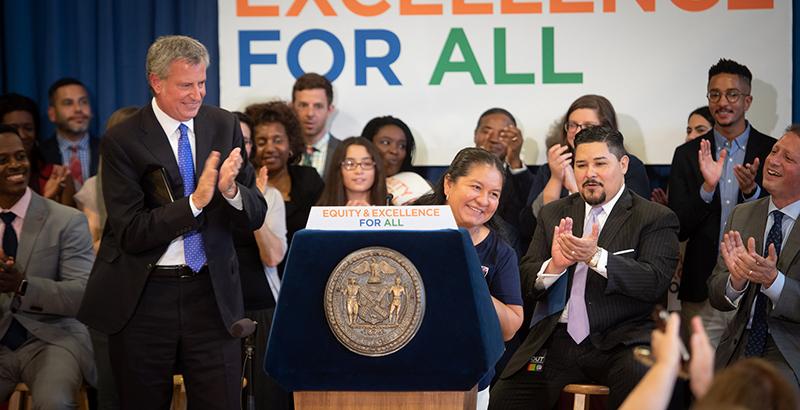Domanico: Racial Integration Isn’t the Answer to a Better Education for NYC’s Black & Latino Students

Racial integration of schools is back on the agenda in New York City, the nation’s largest school system. However, Mayor Bill de Blasio and Chancellor Richard Carranza should temper their expectation that recently enacted changes to middle school admissions policies in two city districts represent the dawn of a new age of racial justice. Much work remains to be done, and tinkering with admission policies at a few schools is a very small piece of it.
Unless the mayor and chancellor engage in a much broader school improvement effort, too many black and Hispanic students will continue to be left out.
Decades ago, New York City schools were geographically zoned, as schools are in most districts across the U.S. But in the late 1980s, proponents of greater school choice, myself and the Manhattan Institute included, argued that low student achievement seemed rooted in the very notion of zoning because the system did not allow families to shop around for better schools without changing their residence. One outcome of this advocacy was the creation of charter schools, as well as hundreds of small public middle and high schools that had no geographic boundaries and were allowed to screen their applicants for admission.
Now, however, the de Blasio administration has become concerned that the concentration of Asian and white children in these screened schools reduces educational opportunities for black and Hispanic students. Thus, the mayor and chancellor recently approved plans by two of the city’s 32 community school districts — Manhattan’s District 3 (Upper West Side and West Harlem) and Brooklyn’s District 15 (Park Slope, Sunset Park, Red Hook) — to change the rules for middle school admissions.
The new rules will take effect for the 2019-20 school year. In District 15, middle schools with more applicants than seats will be required to admit students via lottery, with extra weight given to children who are poor, English learners, or homeless. In District 3, priority admission for 25 percent of the seats in 16 middle schools will be given to students from low-income families who are low-achieving in math and English Language Arts. These changes are expected to racially integrate a number of high-achieving middle schools that have been serving few black or Hispanic students.
But this approach, if expanded, is unlikely to lead to widespread integration because there are simply not enough white students in the city’s public schools. In addition, white students are geographically isolated — half the city’s white middle schoolers live on Staten Island or in southern Brooklyn, and the mayor and chancellor have ruled out busing across school zones.
Before the reforms in Districts 3 and 15, only 11 middle schools served majority Asian or white student bodies and screened all entering students. Four of those schools are in the two districts where admissions processes have just been changed; the remaining schools serve fewer than 5,000 Asian and white students. Directing even half of those seats to black or Hispanic youngsters would not make much of a dent in the number of such students currently stuck in low-performing schools.
The most extreme example of these are the 7,700 black and Hispanic youngsters who remain trapped in 26 middle schools participating in the mayor’s futile school improvement effort now titled the Renewal and Rise programs; in these schools, students are twice as likely to score at the lowest level on state tests as they are to be deemed proficient.
Citywide, 49,000 black and Hispanic middle schoolers scored below proficiency on this year’s state English Language Arts test. That’s 60 percent of the black and Hispanic students in district middle schools.
Meanwhile, more than 113,000 black and Hispanic students have invoked school choice and are enrolled in the city’s public charter schools, and 61,000 more attend private schools, because they could not find satisfactory schools within the Department of Education.
Yet somehow, the mayor and chancellor believe the city needs no more charter schools and that there is no need to raise the cap on the number of charters that are allowed to open, despite their success in closing the achievement gap.
At the same time, there are also numerous district schools, identified in my report, that have majority black and Hispanic enrollments whose students are doing well. The city needs more of those schools, both charter and district, and fewer schools with incredibly low proficiency rates.
Parents from all backgrounds expect the same fundamentals from their schools — they want their children to be safe, to be taught and led by professionally competent teachers and principals, to learn the things they will need to succeed and to be treated fairly. We all share a common interest in seeing to it that few children enter adulthood without the tools and knowledge they need to be healthy, engaged, and productive members of society.
Still, parents need to trust that those in charge are not subverting their own child’s well-being in the pursuit of social goals. That trust is fragile, and parents have options. When families trust that a school or school system is going to hold all students to the same expectations, they are more able to believe that their own child can be well-served alongside students from different backgrounds, behaviors, and challenges. This happens in many well-run district, private, and charter schools every day. But when parents don’t see a reason to trust a school or a school system, they retreat to tribalism and seek schools that enroll only children from families like their own.
A number of the mayor’s first-term actions sent mixed messages to parents. Whatever its long-term impact, his pre-kindergarten expansion has been popular and beneficial to parents trying to juggle their work commitments with childcare responsibilities. At the same time, the mayor has seemed unmoved by the plight of some incredibly low-performing schools, forgoing the difficult action of closing them in favor of expending scarce resources on them, though families of all races avoid them. Where is the commitment to excellence and justice here?
Similarly, the administration’s actions to reduce student suspensions without ensuring that all schools have the ability to maintain order without suspensions could not have reassured many parents that their child’s safety was a primary concern. And regarding the city’s specialized high schools, the mayor’s apparent commitment to meeting predetermined numerical goals for the mix of students, without endorsing a merit-based system of some sort that treats all children equally, is likely to alienate parents of high-performing students.
Both Districts 3 and 15 can be described as politically progressive, and there had been local support for the middle school admissions changes before the mayor got behind them. This is not to say that all parents are on board in those districts; significant numbers are deeply but quietly concerned, fearing that they will be branded as racially insensitive or worse. The impact of these changes will become apparent in the next few years and will be watched closely.
Meantime, it is important that the system’s leadership respect and embrace the school choices made by families from all groups and provide real support to schools that are succeeding even in the face of racial isolation. These schools, traditional district schools, charters, and private schools, are worthy of respect and support.
New York City needs more of them.
Ray Domanico is director of education policy at the Manhattan Institute and author of the forthcoming report “Closing the Racial Achievement Gap in NYC Schools — Integration Is Not Enough.”
Get stories like these delivered straight to your inbox. Sign up for The 74 Newsletter

;)
